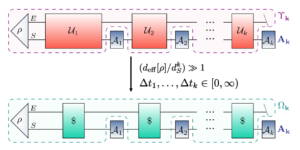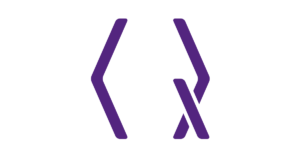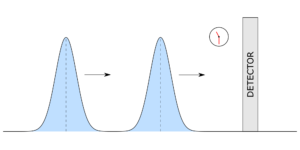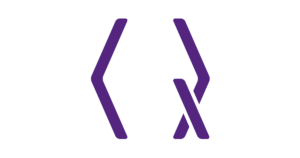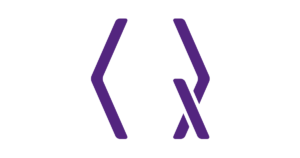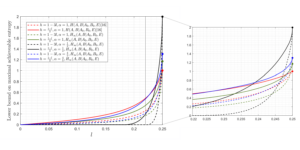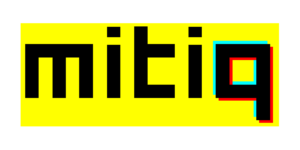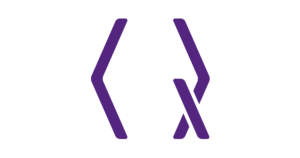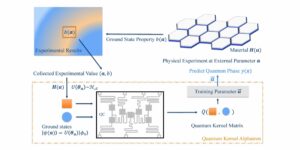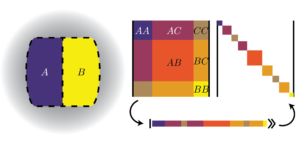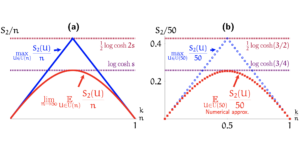1ICFO – Institut de Ciencies Fotoniques, Institutul de Știință și Tehnologie din Barcelona, 08860 Castelldefels (Barcelona), Spania
2Institutul Perimetru pentru Fizică Teoretică, 31 Caroline St. N., Waterloo, Ontario, Canada, N2L 2Y5
3Instituto de Ciencias Matemáticas (CSIC-UAM-UC3M-UCM), 28049 Madrid, Spania
Găsiți această lucrare interesant sau doriți să discutați? Scite sau lasă un comentariu la SciRate.
Abstract
Introducem Inflația, o bibliotecă Python pentru a evalua dacă o distribuție de probabilitate observată este compatibilă cu o explicație cauzală. Aceasta este o problemă centrală atât în științele teoretice, cât și în cele aplicate, care a cunoscut recent progrese semnificative din zona nonlocalității cuantice, și anume, în dezvoltarea tehnicilor inflației. Inflația este un set de instrumente extensibil care este capabil să rezolve probleme de compatibilitate cauzală pură și să optimizeze (relaxările) seturi de corelații compatibile atât în paradigma clasică, cât și în cea cuantică. Biblioteca este concepută pentru a fi modulară și cu capacitatea de a fi gata de utilizare, păstrând în același timp un acces ușor la obiectele de nivel scăzut pentru modificări personalizate.
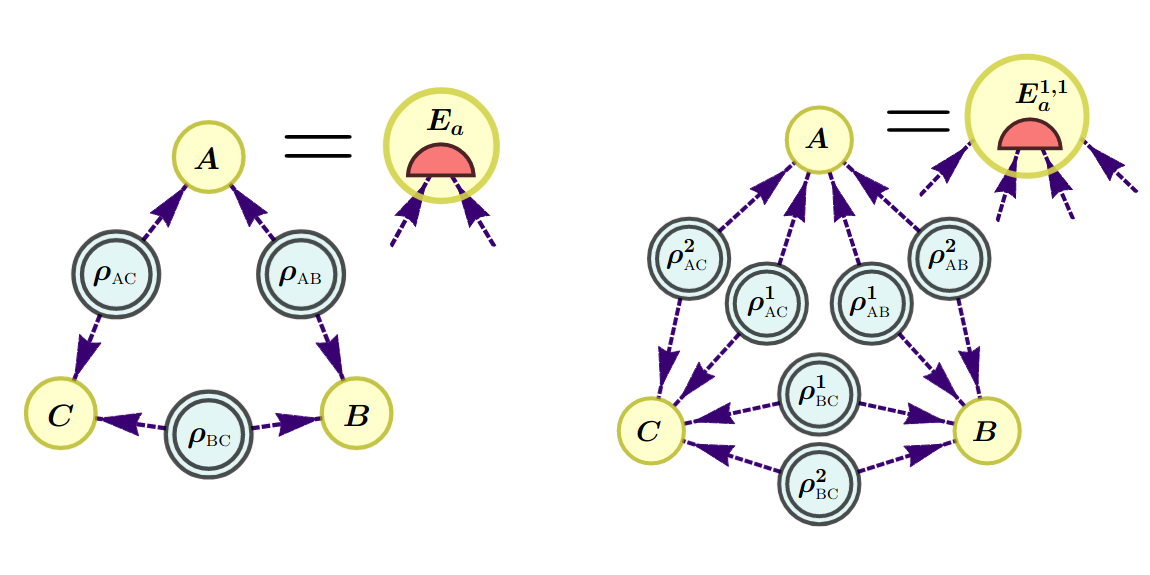
Imagine prezentată: Stânga: scenariul triunghiului, în care valorile a trei variabile aleatoare vizibile, $A$, $B$ și $C$, sunt influențate fiecare de două diferite din cele trei variabile latente $rho_{AB}$, $rho_{BC}$ și $rho_{AC}$. Aceste variabile latente pot fi alese să fie fie surse ale aleatoriei partajate, fie ale stărilor cuantice. Fiecare parte își creează valoarea variabilei aleatoare prin operarea pe sistemele primite, ca în $E_a$. Răspunsul dacă o distribuție de probabilitate peste valorile date de $A$, $B$ și $C$ este compatibilă cu această structură este o problemă dificilă din punct de vedere numeric.
Dreapta: inflația cuantică de ordinul doi a scenariului triunghiului. Inflația ia în considerare copii ale stărilor și măsurătorilor așa cum sunt descrise. Utilizarea de copii ale elementelor originale implică multe simetrii, astfel că distribuțiile compatibile cu acest scenariu pot fi caracterizate prin programare semidefinită.
Rezumat popular
► Date BibTeX
► Referințe
[1] Judea Pearl. “Causality: Models, Reasoning, and Inference”. Cambridge University Press. (2009).
https: / / doi.org/ 10.1017 / CBO9780511803161
[2] Dan Geiger and Christopher Meek. “Quantifier elimination for statistical problems”. In Proc. 15th Conf. Uncert. Artif. Intell. (AUAI, 1999). Page 226–235. (1995). arXiv:1301.6698.
https:///doi.org/10.48550/arXiv.1301.6698
arXiv: 1301.6698
[3] Jin Tian and Judea Pearl. “On the testable implications of causal models with hidden variables”. In Proc. 18th Conf. Uncert. Artif. Intell. (AUAI, 2002). Page 519–527. (2002). arXiv:1301.0608.
https:///doi.org/10.48550/arXiv.1301.0608
arXiv: 1301.0608
[4] Luis David Garcia, Michael Stillman, and Bernd Sturmfels. “Algebraic geometry of Bayesian networks”. J. Symb. Comput. 39, 331–355 (2005). arXiv:math/0301255.
https:///doi.org/10.1016/j.jsc.2004.11.007
arXiv: math / 0301255
[5] Luis David Garcia. “Algebraic statistics in model selection”. In Proc. 20th Conf. Uncert. Artif. Intell. (AUAI, 2004). Page 177–184. (2014). arXiv:1207.4112.
https:///doi.org/10.48550/arXiv.1207.4112
arXiv: 1207.4112
[6] Ciarán M. Lee and Robert W. Spekkens. “Causal inference via algebraic geometry: Feasibility tests for functional causal structures with two binary observed variables”. J. Causal Inference 5, 20160013 (2017). arXiv:1506.03880.
https: / / doi.org/ 10.1515 / jci-2016-0013
arXiv: 1506.03880
[7] Nicolas Brunner, Daniel Cavalcanti, Stefano Pironio, Valerio Scarani și Stephanie Wehner. „Nelocalitatea clopoțelului”. Rev. Mod. Fiz. 86, 419–478 (2014). arXiv:1303.2849.
https: / / doi.org/ 10.1103 / RevModPhys.86.419
arXiv: 1303.2849
[8] John S. Bell. “On the Einstein-Podolsky-Rosen paradox”. Physics Physique Fizika 1, 195–200 (1964).
https: / / doi.org/ 10.1103 / PhysicsPhysiqueFizika.1.195
[9] Christopher J. Wood and Robert W. Spekkens. “The lesson of causal discovery algorithms for quantum correlations: causal explanations of Bell-inequality violations require fine-tuning”. New J. Phys. 17, 033002 (2015). arXiv:1208.4119.
https://doi.org/10.1088/1367-2630/17/3/033002
arXiv: 1208.4119
[10] Rafael Chaves, Richard Kueng, Jonatan B. Brask, and David Gross. “Unifying framework for relaxations of the causal assumptions in Bell’s theorem”. Phys. Rev. Lett. 114, 140403 (2015). arXiv:1411.4648.
https: / / doi.org/ 10.1103 / PhysRevLett.114.140403
arXiv: 1411.4648
[11] Cyril Branciard, Nicolas Gisin, and Stefano Pironio. “Characterizing the nonlocal correlations created via entanglement swapping”. Phys. Rev. Lett. 104, 170401 (2010). arXiv:0911.1314.
https: / / doi.org/ 10.1103 / PhysRevLett.104.170401
arXiv: 0911.1314
[12] Cyril Branciard, Denis Rosset, Nicolas Gisin, and Stefano Pironio. “Bilocal versus nonbilocal correlations in entanglement-swapping experiments”. Phys. Rev. A 85, 032119 (2012). arXiv:1112.4502.
https: / / doi.org/ 10.1103 / PhysRevA.85.032119
arXiv: 1112.4502
[13] Tobias Fritz. “Beyond Bell’s theorem: correlation scenarios”. New J. Phys. 14, 103001 (2012). arXiv:1206.5115.
https://doi.org/10.1088/1367-2630/14/10/103001
arXiv: 1206.5115
[14] Thomas C. Fraser and Elie Wolfe. “Causal compatibility inequalities admitting quantum violations in the triangle structure”. Phys. Rev. A 98, 022113 (2018). arXiv:1709.06242.
https: / / doi.org/ 10.1103 / PhysRevA.98.022113
arXiv: 1709.06242
[15] Thomas van Himbeeck, Jonatan Bohr Brask, Stefano Pironio, Ravishankar Ramanathan, Ana Belén Sainz, and Elie Wolfe. “Quantum violations in the Instrumental scenario and their relations to the Bell scenario”. Quantum 3, 186 (2019). arXiv:1804.04119.
https://doi.org/10.22331/q-2019-09-16-186
arXiv: 1804.04119
[16] Armin Tavakoli, Alejandro Pozas-Kerstjens, Ming-Xing Luo, and Marc-Olivier Renou. “Bell nonlocality in networks”. Rep. Prog. Phys. 85, 056001 (2022). arXiv:2104.10700.
https:///doi.org/10.1088/1361-6633/ac41bb
arXiv: 2104.10700
[17] Alejandro Pozas-Kerstjens, Rafael Rabelo, Łukasz Rudnicki, Rafael Chaves, Daniel Cavalcanti, Miguel Navascués, and Antonio Acín. “Bounding the sets of classical and quantum correlations in networks”. Phys. Rev. Lett. 123, 140503 (2019). arXiv:1904.08943.
https: / / doi.org/ 10.1103 / PhysRevLett.123.140503
arXiv: 1904.08943
[18] Aditya Kela, Kai Von Prillwitz, Johan Åberg, Rafael Chaves, and David Gross. “Semidefinite tests for latent causal structures”. IEEE Trans. Inf. Theory 66, 339–349 (2020). arXiv:1701.00652.
https: / / doi.org/ 10.1109 / TIT.2019.2935755
arXiv: 1701.00652
[19] Johan Åberg, Ranieri Nery, Cristhiano Duarte, and Rafael Chaves. “Semidefinite tests for quantum network topologies”. Phys. Rev. Lett. 125, 110505 (2020). arXiv:2002.05801.
https: / / doi.org/ 10.1103 / PhysRevLett.125.110505
arXiv: 2002.05801
[20] Ming-Xing Luo. “Computationally efficient nonlinear Bell inequalities for quantum networks”. Phys. Rev. Lett. 120, 140402 (2018). arXiv:1707.09517.
https: / / doi.org/ 10.1103 / PhysRevLett.120.140402
arXiv: 1707.09517
[21] Marc-Olivier Renou, Yuyi Wang, Sadra Boreiri, Salman Beigi, Nicolas Gisin, and Nicolas Brunner. “Limits on correlations in networks for quantum and no-signaling resources”. Phys. Rev. Lett. 123, 070403 (2019). arXiv:1901.08287.
https: / / doi.org/ 10.1103 / PhysRevLett.123.070403
arXiv: 1901.08287
[22] Elie Wolfe, Robert W. Spekkens, and Tobias Fritz. “The inflation technique for causal inference with latent variables”. J. Causal Inference 7, 20170020 (2019). arXiv:1609.00672.
https: / / doi.org/ 10.1515 / jci-2017-0020
arXiv: 1609.00672
[23] Elie Wolfe, Alejandro Pozas-Kerstjens, Matan Grinberg, Denis Rosset, Antonio Acín, and Miguel Navascués. “Quantum inflation: A general approach to quantum causal compatibility”. Phys. Rev. X 11, 021043 (2021). arXiv:1909.10519.
https: / / doi.org/ 10.1103 / PhysRevX.11.021043
arXiv: 1909.10519
[24] Nicolas Gisin, Jean-Daniel Bancal, Yu Cai, Patrick Remy, Armin Tavakoli, Emmanuel Zambrini Cruzeiro, Sandu Popescu, and Nicolas Brunner. “Constraints on nonlocality in networks from no-signaling and independence”. Nat. Commun. 11, 2378 (2020). arXiv:1906.06495.
https://doi.org/10.1038/s41467-020-16137-4
arXiv: 1906.06495
[25] Alejandro Pozas-Kerstjens, Nicolas Gisin, and Armin Tavakoli. “Full network nonlocality”. Phys. Rev. Lett. 128, 010403 (2022). arXiv:2105.09325.
https: / / doi.org/ 10.1103 / PhysRevLett.128.010403
arXiv: 2105.09325
[26] Alejandro Pozas-Kerstjens, Nicolas Gisin, and Marc-Olivier Renou. “Proofs of network quantum nonlocality in continuous families of distributions”. Phys. Rev. Lett. 130, 090201 (2023). arXiv:2203.16543.
https: / / doi.org/ 10.1103 / PhysRevLett.130.090201
arXiv: 2203.16543
[27] Emanuel-Cristian Boghiu, Elie Wolfe, and Alejandro Pozas-Kerstjens. “Source code for inflation”. Zenodo 7305544 (2022).
https: / / doi.org/ 10.5281 / zenodo.7305544
[28] Flavio Baccari, Daniel Cavalcanti, Peter Wittek, and Antonio Acín. “Efficient device-independent entanglement detection for multipartite systems”. Phys. Rev. X 7, 021042 (2017). arXiv:1612.08551.
https: / / doi.org/ 10.1103 / PhysRevX.7.021042
arXiv: 1612.08551
[29] Greg ver Steeg and Aram Galstyan. “A sequence of relaxations constraining hidden variable models”. In Proceedings of the Twenty-Seventh Conference on Uncertainty in Artificial Intelligence. Page 717–726. UAI’11Arlington, Virginia, USA (2011). AUAI Press. arXiv:1106.1636.
https:///doi.org/10.48550/arXiv.1106.1636
arXiv: 1106.1636
[30] Miguel Navascués and Elie Wolfe. “The inflation technique completely solves the causal compatibility problem”. J. Causal Inference 8, 70 – 91 (2020). arXiv:1707.06476.
https: / / doi.org/ 10.1515 / jci-2018-0008
arXiv: 1707.06476
[31] Laurens T. Ligthart and David Gross. “The inflation hierarchy and the polarization hierarchy are complete for the quantum bilocal scenario” (2022). arXiv:2212.11299.
arXiv: 2212.11299
[32] Laurens T. Ligthart, Mariami Gachechiladze, and David Gross. “A convergent inflation hierarchy for quantum causal structures” (2021). arXiv:2110.14659.
arXiv: 2110.14659
[33] Charles R. Harris, K. Jarrod Millman, Stéfan J. van der Walt, et al. “Array programming with NumPy”. Nature 585, 357–362 (2020).
https://doi.org/10.1038/s41586-020-2649-2
[34] Aaron Meurer, Christopher P. Smith, Mateusz Paprocki, et al. “SymPy: symbolic computing in Python”. PeerJ Comput. Sci. 3, e103 (2017).
https:///doi.org/10.7717/peerj-cs.103
[35] Pauli Virtanen, Ralf Gommers, Travis E. Oliphant, et al. “SciPy 1.0: Fundamental Algorithms for Scientific Computing in Python”. Nat. Methods 17, 261–272 (2020).
https://doi.org/10.1038/s41592-019-0686-2
[36] Siu Kwan Lam, Antoine Pitrou, and Stanley Seibert. “Numba: A LLVM-based Python JIT compiler”. In Proceedings of the Second Workshop on the LLVM Compiler Infrastructure in HPC. LLVM ’15 New York, NY, USA (2015). Association for Computing Machinery.
https: / / doi.org/ 10.1145 / 2833157.2833162
[37] MOSEK ApS. “MOSEK Fusion API for Python”. https://docs.mosek.com/latest/pythonfusion/index.html (2019).
https:///docs.mosek.com/latest/pythonfusion/index.html
[38] Johann Löfberg. “YALMIP: A toolbox for modeling and optimization in MATLAB”. In Proceedings of the CACSD Conference. Taipei, Taiwan (2004). url: yalmip.github.io/.
https:///yalmip.github.io/
[39] Miguel Navascués, Stefano Pironio, and Antonio Acín. “Bounding the set of quantum correlations”. Phys. Rev. Lett. 98, 010401 (2007). arXiv:quant-ph/0607119.
https: / / doi.org/ 10.1103 / PhysRevLett.98.010401
arXiv: Quant-ph / 0607119
[40] Miguel Navascués, Stefano Pironio, and Antonio Acín. “A convergent hierarchy of semidefinite programs characterizing the set of quantum correlations”. New J. Phys. 10, 073013 (2008). arXiv:0803.4290.
https://doi.org/10.1088/1367-2630/10/7/073013
arXiv: 0803.4290
[41] Stefano Pironio, Miguel Navascués, and Antonio Acín. “Convergent relaxations of polynomial optimization problems with non-commuting variables”. SIAM J. Optim. 20, 2157–2180 (2010). arXiv:0903.4368.
https: / / doi.org/ 10.1137 / 090760155
arXiv: 0903.4368
[42] Tobias Moroder, Jean-Daniel Bancal, Yeong-Cherng Liang, Martin Hofmann, and Otfried Gühne. “Device-independent entanglement quantification and related applications”. Phys. Rev. Lett. 111, 030501 (2013). arXiv:1302.1336.
https: / / doi.org/ 10.1103 / PhysRevLett.111.030501
arXiv: 1302.1336
[43] Alejandro Pozas-Kerstjens. “Quantum information outside quantum information”. PhD thesis. Universitat Politécnica de Catalunya. (2019). url: http://hdl.handle.net/10803/667696.
http: / / hdl.handle.net/ 10803 / 667696
[44] N. David Mermin. „Mistere cuantice revăzute”. Amer. J. Fiz. 58, 731–734 (1990).
https: / / doi.org/ 10.1119 / 1.16503
[45] Paolo Abiuso, Tamás Kriváchy, Emanuel-Cristian Boghiu, Marc-Olivier Renou, Alejandro Pozas-Kerstjens, and Antonio Acín. “Single-photon nonlocality in quantum networks”. Phys. Rev. Research 4, L012041 (2022). arXiv:2108.01726.
https:///doi.org/10.1103/PhysRevResearch.4.L012041
arXiv: 2108.01726
[46] Mariami Gachechiladze, Nikolai Miklin, and Rafael Chaves. “Quantifying causal influences in the presence of a quantum common cause”. Phys. Rev. Lett. 125, 230401 (2020). arXiv:2007.01221.
https: / / doi.org/ 10.1103 / PhysRevLett.125.230401
arXiv: 2007.01221
[47] Iris Agresti, Davide Poderini, Leonardo Guerini, Michele Mancusi, Gonzalo Carvacho, Leandro Aolita, Daniel Cavalcanti, Rafael Chaves, and Fabio Sciarrino. “Experimental device-independent certified randomness generation with an instrumental causal structure”. Commun. Phys. 3, 110 (2020). arXiv:1905.02027.
https://doi.org/10.1038/s42005-020-0375-6
arXiv: 1905.02027
[48] Iris Agresti, Davide Poderini, Beatrice Polacchi, Nikolai Miklin, Mariami Gachechiladze, Alessia Suprano, Emanuele Polino, Giorgio Milani, Gonzalo Carvacho, Rafael Chaves, and Fabio Sciarrino. “Experimental test of quantum causal influences”. Sci. Adv. 8, eabm1515 (2022). arXiv:2108.08926.
https:///doi.org/10.1126/sciadv.abm1515
arXiv: 2108.08926
[49] Shane Mansfield and Tobias Fritz. “Hardy’s non-locality paradox and possibilistic conditions for non-locality”. Found. Phys. 42, 709–719 (2012). arXiv:1105.1819.
https://doi.org/10.1007/s10701-012-9640-1
arXiv: 1105.1819
[50] Denis Rosset, Felipe Montealegre-Mora, and Jean-Daniel Bancal. “RepLAB: A computational/numerical approach to representation theory”. In Quantum Theory and Symmetries. Pages 643–653. CRM Series in Mathematical Physics. Proceedings of the 11th International Symposium, Montreal, Springer (2021). arXiv:1911.09154.
https://doi.org/10.1007/978-3-030-55777-5_60
arXiv: 1911.09154
[51] Kim-Chuan Toh, Michael J. Todd, and Reha H. Tütüncü. “SDPT3 — a MATLAB software package for semidefinite programming”. Optim. Metods Softw. 11, 545–581 (1999).
https: / / doi.org/ 10.1080 / 10556789908805762
[52] Steven Diamond and Stephen Boyd. “CVXPY: A Python-embedded modeling language for convex optimization”. J. Mach. Learn. Res. 17, 1–5 (2016). arXiv:1603.00943.
https:///doi.org/10.48550/arXiv.1603.00943
arXiv: 1603.00943
[53] Brendan O’Donoghue, Eric Chu, Neal Parikh, and Stephen Boyd. “SCS: Splitting Conic Solver”. https://github.com/cvxgrp/scs (2021).
https:///github.com/cvxgrp/scs
[54] Gurobi Optimization, LLC. “Gurobi Optimizer Reference Manual”. https://www.gurobi.com (2022).
https:///www.gurobi.com
[55] Guillaume Sagnol and Maximilian Stahlberg. “PICOS: A Python interface to conic optimization solvers”. J. Open Source Softw. 7, 3915 (2022).
https: / / doi.org/ 10.21105 / joss.03915
[56] Martin S. Andersen, Joachim Dahl, and Lieven Vandenberghe. “CVXOPT: Python software for convex optimization”. http://cvxopt.org/ (2015).
http:///cvxopt.org/
[57] Daniel Brosch and Etienne de Klerk. “Jordan symmetry reduction for conic optimization over the doubly nonnegative cone: theory and software”. Optim. Methods Softw. 37, 2001–2020 (2022). arXiv:2001.11348.
https: / / doi.org/ 10.1080 / 10556788.2021.2022146
arXiv: 2001.11348
Citat de
[1] Robin Lorenz și Sean Tull, „Modele cauzale în diagrame cu șiruri”, arXiv: 2304.07638, (2023).
Citatele de mai sus sunt din ADS SAO / NASA (ultima actualizare cu succes 2023-05-05 01:00:09). Lista poate fi incompletă, deoarece nu toți editorii furnizează date de citare adecvate și complete.
On Serviciul citat de Crossref nu s-au găsit date despre citarea lucrărilor (ultima încercare 2023-05-05 01:00:08).
Acest Lucru este publicat în Quantum sub Creative Commons Atribuire 4.0 internațională (CC BY 4.0) licență. Drepturile de autor rămân la deținătorii de drepturi de autor originale, precum autorii sau instituțiile lor.
- Distribuție de conținut bazat pe SEO și PR. Amplifică-te astăzi.
- PlatoAiStream. Web3 Data Intelligence. Cunoștințe amplificate. Accesați Aici.
- Mintând viitorul cu Adryenn Ashley. Accesați Aici.
- Cumpărați și vindeți acțiuni în companii PRE-IPO cu PREIPO®. Accesați Aici.
- Sursa: https://quantum-journal.org/papers/q-2023-05-04-996/
- :are
- :este
- :nu
- ][p
- 1
- 10
- 11
- 110
- 12
- 13
- 14
- 15%
- 195
- 1999
- 20
- 2001
- 2011
- 2012
- 2014
- 2015
- 2016
- 2017
- 2018
- 2019
- 2020
- 2021
- 2022
- 2023
- 22
- 23
- 24
- 26
- 27
- 28
- 30
- 39
- 40
- 49
- 50
- 66
- 7
- 70
- 8
- 9
- 91
- 98
- a
- Aaron
- capacitate
- mai sus
- REZUMAT
- acces
- avans
- afilieri
- împotriva
- AL
- algoritmi
- TOATE
- permite
- an
- Ana
- și
- Andersen
- răspunde
- api
- a apărut
- aplicatii
- aplicat
- abordare
- SUNT
- ZONĂ
- artificial
- inteligență artificială
- AS
- evaluarea
- Asociație
- autor
- Autorii
- Barcelona
- Bayesian
- BE
- Beatrice
- în spatele
- fiind
- Clopot
- atât
- Pauză
- dar
- by
- denumit
- Cambridge
- CAN
- Canada
- capabil
- Provoca
- cauze
- central
- Certificate
- provocări
- caracterizat
- Charles
- ales
- Christopher
- cod
- COM
- comentariu
- Comun
- Commons
- compatibilitate
- compatibil
- Completă
- complet
- tehnica de calcul
- Condiții
- Conferință
- consideră
- continuu
- Convex
- copii
- drepturi de autor
- Corelație
- a creat
- creează
- CRM
- personalizat
- Daniel
- de date
- David
- Ea
- proiectat
- Detectare
- Dezvoltare
- diagrame
- Diamant
- diferit
- descoperire
- discuta
- Boală
- distribuire
- distribuții
- face
- de două ori
- e
- E&T
- fiecare
- uşor
- Eficace
- eficient
- oricare
- element
- încuraja
- Eter (ETH)
- experimente
- explicație
- familii
- camp
- Pentru
- găsit
- Cadru
- din
- funcțional
- fundamental
- fuziune
- General
- generaţie
- geometrie
- GitHub
- brut
- manipula
- Greu
- harvard
- Avea
- Ascuns
- ierarhie
- Titularii
- hpc
- HTML
- http
- HTTPS
- identificarea
- IEEE
- imagine
- ustensile
- implicații
- in
- independenţă
- inegalitățile
- inflaţiei
- influențat
- informații
- Infrastructură
- Institut
- instituții
- instrumental
- Inteligență
- interesant
- interfaţă
- Internațional
- introduce
- JavaScript
- JIT
- Ioan
- jurnal
- păstrare
- Cotonogi
- limbă
- Nume
- AFLAȚI
- Părăsi
- Sub vânt
- stânga
- lecţie
- Bibliotecă
- Licență
- Listă
- LLC
- mașini
- Principal
- manual
- multe
- Martin
- matematic
- max-width
- Mai..
- măsurători
- Metode
- Michael
- model
- modelare
- Modele
- modificările aduse
- modular
- Lună
- Montreal
- și anume
- Natură
- reţea
- rețele
- Nou
- New York
- Nicolas
- Nu.
- NumPy
- NY
- obiecte
- of
- de multe ori
- on
- cele
- Ontario
- deschide
- open-source
- de operare
- optimizare
- or
- original
- afară
- producție
- exterior
- peste
- pachet
- pagină
- Paul
- Hârtie
- Paradox
- parte
- Peter
- Fizică
- Plato
- Informații despre date Platon
- PlatoData
- prezenţă
- prezenta
- presa
- probabilitate
- Problemă
- probleme
- PROC
- Proceedings
- Programare
- Programe
- furniza
- publicat
- editor
- editori
- Piton
- Cuantic
- informație cuantică
- rețele cuantice
- Întrebări
- Rafael
- ridicare
- Ralf
- aleator
- dezordine
- primit
- recent
- reducere
- referințe
- legate de
- relaţii
- Relaxa
- rămășițe
- reprezentare
- necesita
- cercetare
- Resurse
- Richard
- ROBERT
- prihor
- s
- salarii
- scenariu
- scenarii
- SCI
- Ştiinţă
- Ştiinţă şi Tehnologie
- ȘTIINȚE
- Sean
- Al doilea
- selecţie
- Secvenţă
- serie
- set
- Seturi
- comun
- Siamului
- semnificativ
- So
- Software
- rezolvă
- Rezolvarea
- unele
- Sursă
- Surse
- Cheltuire
- Stanley
- Statele
- statistic
- statistică
- Stephen
- Şir
- structura
- Reușit
- astfel de
- potrivit
- Simpozion
- sisteme
- Taiwan
- tehnici de
- Tehnologia
- test
- teste
- acea
- Zona
- lor
- teoretic
- Acestea
- teză
- acest
- trei
- Titlu
- la
- Toolbox
- Toolkit
- Unelte
- Două
- Incertitudine
- în
- universitate
- actualizat
- URL-ul
- Statele Unite ale Americii
- utilizare
- folosind
- Vaccin
- valoare
- Valori
- Impotriva
- de
- încălcări
- Virginia
- vizibil
- volum
- de
- W
- vrea
- a fost
- we
- dacă
- care
- în timp ce
- cu
- asistat
- lemn
- Apartamente
- fabrică
- atelier
- X
- an
- York
- zephyrnet

